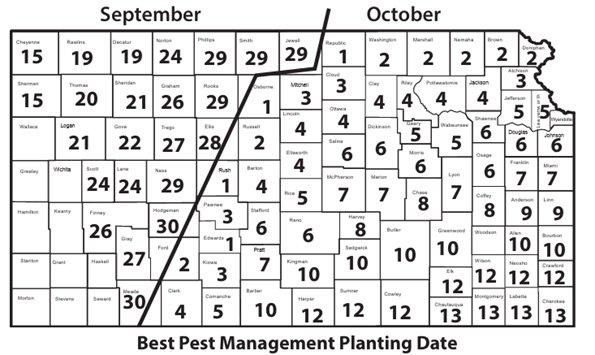Controlling volunteer wheat this summer and now into early Fall has been challenging. While we are always thankful for the needed moisture. It has caused several flushes of volunteer wheat now. And I hate to be the bearer of bad news but continuing to control all volunteer wheat is still important.
A late flush of volunteer wheat likely is harboring fewer wheat curl mites the vector of Wheat Streak Mosaic Virus (WSMV) complex. Than volunteer wheat that has been established for a while. There is still time to go out and control those late flushes of volunteer wheat before planting begins.
The general target date for planting wheat for optimum grain yields in Kansas is within a week of the best pest management planting date, or BPMP (formerly known as the “Hessian fly-free”) date (Figure 1). Planting after these dates not only benefits grain yield, but may help reduce the risk of serious pests and diseases that can damage the wheat crop in Kansas. If forage production is the primary goal, earlier planting (mid-September) can increase forage yield. However, if grain yield is the primary goal, then waiting until the BPMP date to start planting is the best approach. Planting in mid-September is ideal for dual-purpose wheat systems where forage yields need to be maximized while reducing the effects of early planting on reduced grain yields.
For growers considering planting early, a good management consideration would be to select wheat varieties with resistance to the wheat streak mosaic virus and/or with tolerance to the wheat curl mite, especially in the western portions of the state. Updated disease and insect ratings for wheat varieties can be found with an internet search for K-State Extension Wheat Variety Guide 2025.
Armyworms and other lepidopteran larvae may also still pose a serious problem to early planted wheat. They may feed on the green wheat plants until the first cold front comes through (temperatures in the mid-20-degree F range for a couple of hours). Insecticide seed treatments do not work well against lepidoptera larvae.
Fall Armyworm/Armyworm Considerations in Volunteer Wheat - because of the large armyworm and fall armyworm populations this year and in years past, some producers are considering adding insecticide to volunteer wheat herbicide applications to save on costs. However, this is not recommended. First, destroying volunteer wheat will starve larvae, push them into pupation, or expose them to predators. Second, insecticides should only be used when pests are at a vulnerable stage and above treatment thresholds. Finally, any insecticide applied now will lose activity long before planted wheat emerges. Control the volunteer wheat, but resist the urge to tank-mix insecticide.
Take-home message - early planting of wheat can increase risks that affect stand establishment and yield:
• Disease risk: Greater chance of insect- or mite-transmitted viral diseases.
• Emergence challenges: High temperatures can reduce germination and shorten coleoptile length in some varieties.
• Optimal planting: Aim for the recommended planting window whenever possible.
• Variety selection: If planting early (due to moisture or dual-purpose systems), choose varieties tolerant to major regional yield-limiting factors.
• Seed treatments: Strongly consider fungicide and insecticide seed treatments when planting early in Kansas.
Stacy Campbell is an Agriculture and Natural Resources agent for Cottonwood Extension District. Email him at scampbel@ksu.eduor call the Hays office, 785-628-9430.





